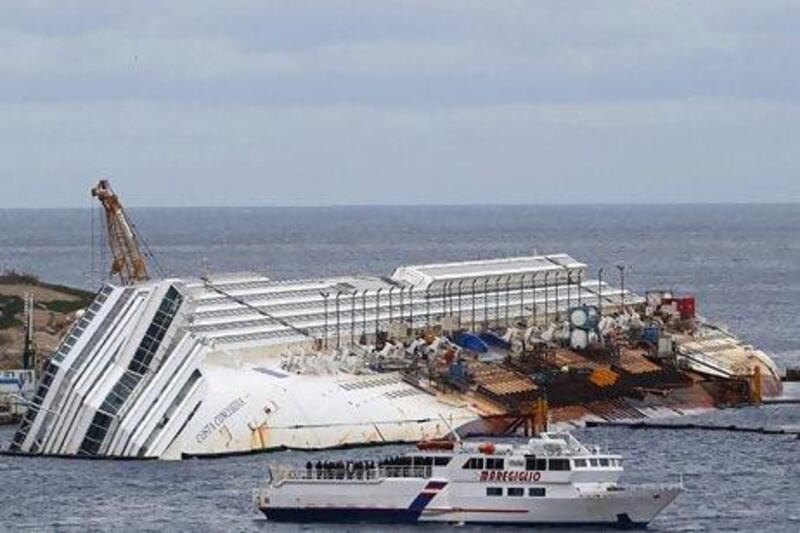The world's merchant marine has reported the loss of 106 ships last year. The figure is up from the 91 ships reported lost in 2011, but well below the 10-year average of 146 ships per annum.
On the first anniversary of the most spectacular loss of the year - the running aground of the 114,137 tonne cruise liner Costa Concordia, the marine insurer Allianz Global Corporate & Specialty has revealed the figures in its latest annual Safety and Shipping Review.
According to the review, despite the continuing downward trend in losses - last year's losses were 27 per cent below the average annual losses since 2002 - the seas around Southern China, Indochina, Indonesia and the Philippines continue to be a "black spot" for marine accidents.
"Twice as many shipping accidents centred on the seas around [South East Asia] with 30 ships reported lost," said the review. "Shipping losses also occurred more often in the East Mediterranean and the Black Sea with 15 losses in 2012 and around Japan, Korea and North China with 10 losses."
Human error remains a root cause of most incidents, according to Sven Gerhard, who is the global head of Marine Hull Liabilities at Allianz.
"Fatigue, economic pressures, and inadequate training are causes for concern," he said. "For some commercial ship owners, especially in the hard-pressed bulk cargo and tanker sectors, there is little money for maintenance and little money for training."
According to the review, "foundering" - a ship actually sinking - was the most common cause of losses in the past year accounting for 49 per cent of all losses, followed by running aground which accounted for 22 per cent.
Collisions, on the other hand, such as that involving the Baltic Ace and Corvus Jearly last month accounted for a relatively small number of losses, just 6 per cent.
Technology, training and regulation, and a proactive response from the shipping industry to safety improvement, had all helped to cut losses in recent years, added Mr Gerhard.
However, the year was marked by two high profile accidents with the loss of the Costa Concordia off Italy on January 13, 2012, followed by that of the ferry, Rabaul Queen, off Papua New Guinea on February 2 both accidents causing terrible loss of life. The Costa Concordia ripped a huge hole in her hull after manoeuvering too close to the Italian island of Giglio. Of the 4,229 passengers and crew on board, 32 lost their lives during the evacuation of the ship.
While 161 people died on the Rabaul Queen, which was licensed to carry 310 passengers and crew, but was probably transporting over 400 people when she capsized in heavy seas.
As a result new regulations are focusing on the problem of human error. The Maritime Labor Convention 2006, which comes into force later this year, will help to improve safety by addressing the welfare and working conditions of seafarers.
In general, passenger vessels have been the focus of attention throughout the year with both the International Maritime Organisation and the cruise ship industry taking action to tighten regulation and continuously improve operational practices.
"Major shipping companies have initiated self-regulation initiatives post-Costa Concordia, with the Cruise Lines International Association and the European Cruise Council partnering up to lead the industry-wide voluntary adoption of policies that go beyond international regulatory requirements," said the review.
"In addition, moves previously pioneered in other industries, such as the airline industry, or by leading ship owners are gathering force: for example, greater adoption across the industry of the 'function-based bridge' concept whereby the bridge command structure changes from the traditional captain's sole command towards a 'check and balance' approach.
"We see such self-regulation of the industry as the core driver of safety," said Mr Gerhard, who believes that such concepts will soon trickle down to other sectors where passenger safety is paramount.
In addition, the review said technological improvements such as the introduction of mandatory Electronic Chart Display and Information Systems in July last year are expected to reduce accidents, but only where properly applied with effective training and management oversight.
"Technology is only as useful as the training behind it - and we don't always see this human element keeping up with other advances. What we do see with the best ship owners is a proactive safety management culture, going beyond the minimum standards and running from top to bottom of the organisation. This can really make an impact in improving safety," Mr Gerhard added.
Allianz is one of the world's leading marine insurers, offering insurance cover for all types of modern shipping including tankers, bulk carriers, container ships and passenger vessels. It also offers cargo insurance, covering physical loss or damage to international and domestic goods in transit. In 2011, Allianz's marine business generated more than €940 million (Dh4.6 billion) in insurance premiums.





